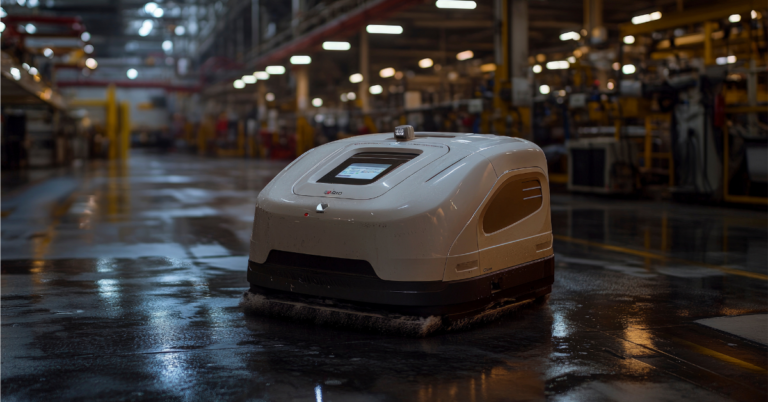The time has come again for new year predictions to trickle in from companies and robotics leaders. But what weight do predictions truly hold when each year proves to be as unpredictable as the next?
Rather than casting vague predictions for robotics in 2024, we’ve taken some observations from this year and applied them to how we believe they’ll translate into the next.
In 2023, we predicted an uptick in robotics-as-a-service (RaaS) growth to ease economic challenges, the metaverse’s grand entrance to robotics, and an increase in the use of 5G. While RaaS businesses continue to receive strong growth projections, the metaverse fell somewhat short of generative AI’s significant breakthroughs earlier this year. 5G proved to support a variety of robots in their duties across the world, from powering delivery robots in Georgia to helping robots clean rivers in Singapore.
Once again, we look ahead to another year. Below, we’ve compiled our predictions for robotics in 2024 based on observations witnessed this year to help you adjust your strategy accordingly.
A Potentially Slow Start
Starting on a realistic note, it’s clear the economy has been a challenge for almost all businesses- especially in the tech sector, and robotics has not been exempt from these struggles.
The NASDAQ has made the prediction of a slow start for robotics in the beginning of 2024, citing economic challenges and high interest rates continued from this year. These challenges have translated to the issue of a lack of funding available to robotic startups, which was already observed this year, meaning those seeking funding may still weather difficult times ahead.
However, it doesn’t have to be all doom and gloom; the 2023 World Robotics Report projects robot installations to reach nearly 600,000 installs in 2024, surpassing an important benchmark that signals robotics will continue to experience ongoing growth despite economic challenges. Also, a slower start provides an opportunity for robotics companies to evaluate their go-to-market strategies and ensure they’re positioned correctly. As interest rates fluctuate, it’s worth it to map out approaches regarding funding and resource allocation, taking the year’s other potential trends into mind.
Generative AI: Redefining Robot Data
Generative AI made a large splash onto the scene earlier this year, with many workers going from never before hearing of ChatGPT to utilizing it every day, along with other AI tools that followed.
Quickly, it proved to be an emerging transformative force within robotics. At Formant, we announced our integration with GPT-4, Theopolis, to help any user become a data scientist. The wider robotics industry has also made much progress with AI- from Boston Dynamic turning Spot into a tour guide to NVIDIA teaching robot simulations how to twirl pens, robots and their data are quickly advancing to become more useful.
Looking ahead, as the initial shock and awe winds down we’ll continue to see more robotics companies further integrate AI with their systems to help robots learn faster and communicate critical data. And while customers are undoubtedly concerned about data, their primary focus remains on the swift and efficient completion of tasks, surpassing the efficiency of their previous methods. Using AI to collect vital performance data that proves ROI and better informs robotic processes is of the utmost importance. Without it, robotics companies risk losing their competitive edge in a time where future customers expect AI integrations as the status quo.
We’ll also see enterprises hopping onto the same train of thought, specifically taking a deeper look at how AI can help manage large amounts of data at scale. Enterprise fleets typically tackle a variety of environments and tasks- whereas one fleet may be cleaning hotels, another patrols a hospital parking lot to strengthen security. With juggling multiple applications comes an incredible amount of differing data that needs to be organized and visualized carefully. It’s likely we will see many enterprises looking to partner with AI providers to ensure large commercial fleets are operating as efficiently as possible.
The Rise of Enterprise Fleets
Speaking of enterprise, a rise in AI applications isn’t the only development we expect to see.
In early October, we announced our $21 million raise, echoing the resounding growth in enterprise robotics we experienced in the past 12 months. This expansion isn’t just unique to Formant- enterprises are quickly closing in on robotics for the sake of operational efficiency and future-proofing their processes. This intent to automate their industries will help them also expand into markets previously untouched by robots, helping environments from medical facilities to restaurants, automotive facilities, and more achieve tasks faster and cheaper than ever.
Strategic partnerships, exemplified by the collaboration between Kia and Boston Dynamics, signal a new era where enterprises actively seek to automate industries with established robotics partners. These collaborations will surely help them bring new robotic solutions to market quicker than they can on their own. However, we’ll also see some enterprise companies purchase devices from other vendors to quicken the process and avoid attempting to reinvent the wheel.
Addressing Customer Acquisition Challenges
For our final 2024 robotics prediction, we have to travel back a few months. In June, we released the results of our State of RaaS 2023 Report which held findings gathered from over 300 robotics professionals. Among the various company sizes surveyed, the struggle to close new deals was particularly noteworthy. Interestingly, this challenge was most pronounced in companies with over one thousand employees, where nearly 50 percent reported issues with customer acquisition.
Companies weathering this challenge face a dilemma – not only are potential customers more cautious and conservative in their investments in an uncertain economy, but the companies themselves are dealing with internal financial constraints. These factors combined created a perfect storm, where even established robotics companies find themselves grappling with the need to develop new sales strategies. To respond, we believe the new year will lead many robotics companies to recalibrate, evaluating their go-to-market strategies to ensure they’re as well-positioned as possible with current market needs. Even larger companies, traditionally accustomed to a certain market positioning, will have to contend with the need for agility in response to changing economic dynamics, such as identifying new market niches, fine-tuning product offerings, and increasing investment in marketing efforts to explore new audiences.
A noteworthy model also gaining traction is building a company that automates a vertical by acquiring traditional businesses versus standard robotics models that only sell hardware. By acquiring businesses and automating each process with AI and physical automation as a complement to human labor, they position themselves as comprehensive solution providers. Here, robots play a smaller but still important role in continuing to automate and optimize processes. This can be seen in companies such as Electric Sheep Robotics, who has recently announced several acquisitions within the landscaping market. This approach works twofold to address customer acquisition challenges and establish a deeper stake within the industries these companies serve. As smaller-scale robotics companies continue to be impacted by the economy and funding challenges, we’re likely to see this model take a stronger hold in the industry.
Of course, there always proves to be a few curveballs thrown throughout the year, especially across tech. 2023 proved to be a difficult whirlwind, yet one that with the help of AI, changed the industry and robotic solutions forever. While we can only attempt to make predictions on what 2024 holds for robotics, we hope it brings prosperity to each company and innovation to the sectors that need it most.



